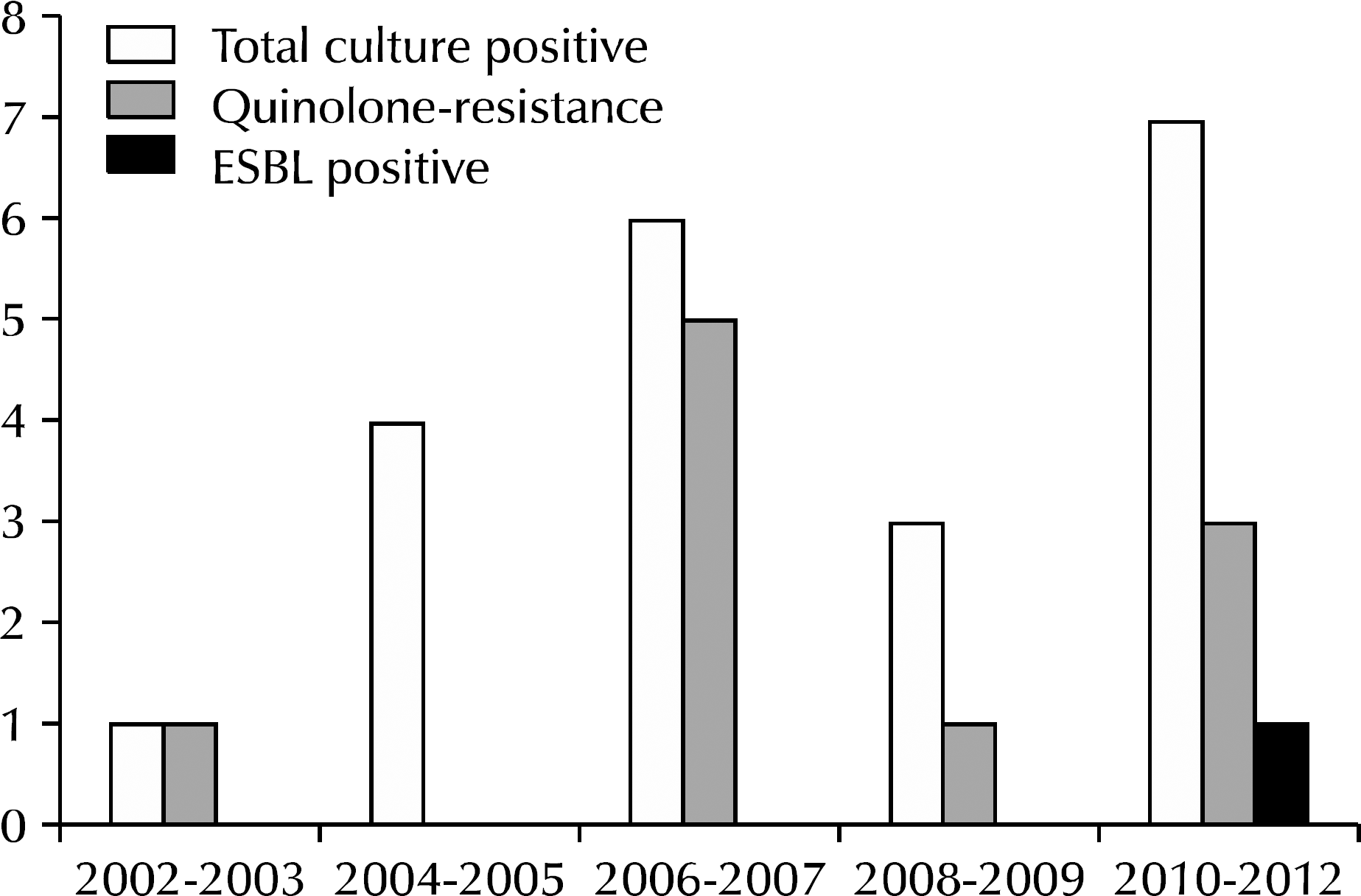Abstract
Purpose
We conducted a retrospective study to investigate causative bacteria of adult epididymitis and their characteristics and resistance in the recent 10 years at a tertiary hospital.
Materials and Methods
We reviewed the medical records of 121 patients who were diagnosed with acute epididymitis from 2002 to 2012. Diagnosis was based on symptoms, physical examination, and ultrasonography. We analyzed causative organisms and changes of antibiotic resistance pattern according to time course in the recent 10 years.
Results
The most commonly detected bacteria were Pseudomonas aeruginosa and Escherichia coli. Fluouroquinolone resistance has emerged since 2006 and 50% of the patients have resistance to fluouroquinolones.
Conclusions
Quinolone resistance composes a major proportion of the causative organism. Therefore, while according to the guidelines, fluoroquinolone may be the first response for elderly men, we recommend that antibiotic resistance should be considered if fever persists, and other antibiotics could be included.
REFERENCES
1. Trojian TH, Lishnak TS, Heiman D. Epididymitis and orchitis: an overview. Am Fam Physician. 2009; 79:583–7.
2. Holmes KK, Berger RE, Alexander ER. Acute epididymitis: etiology and therapy. Arch Androl. 1979; 3:309–16.

3. Kaver I, Matzkin H, Braf ZF. Epididymo-orchitis: a retrospective study of 121 patients. J Fam Pract. 1990; 30:548–52.
4. Falagas ME, Karageorgopoulos DE. Extended-spectrum beta-lactamase-producing organisms. J Hosp Infect. 2009; 73:345–54.
5. Hoban DJ, Lascols C, Nicolle LE, Badal R, Bouchillon S, Hackel M, et al. Antimicrobial susceptibility of Enterobacteriaceae, including molecular characterization of extended-spectrum beta-lactamase-producing species, in urinary tract isolates from hospitalized patients in North America and Europe: results from the SMART study 2009-2010. Diagn Microbiol Infect Dis. 2012; 74:62–7.

6. Paterson DL, Bonomo RA. Extended-spectrum beta-lactamases: a clinical update. Clin Microbiol Rev. 2005; 18:657–86.
7. Ludwig M. Diagnosis and therapy of acute prostatitis, epididymitis and orchitis. Andrologia. 2008; 40:76–80.

8. Pepe P, Panella P, Pennisi M, Aragona F. Does color Doppler sonography improve the clinical assessment of patients with acute scrotum? Eur J Radiol. 2006; 60:120–4.

9. Iannicelli E, Sessa B, Sapori A, Cappucci M, Briani C, Federici GF, et al. Scrotal ultrasound: anatomy and pathological findings. Clin Ter. 2013; 164:e63–75.
10. Joly-Guillou ML, Lasry S. Practical recommendations for the drug treatment of bacterial infections of the male genital tract including urethritis, epididymitis and prostatitis. Drugs. 1999; 57:743–50.

11. Ostaszewska I, Zdrodowska-Stefanow B, Darewicz B, Darewicz J, Badyda J, Puciło K, et al. Role of Chlamydia trachomatis in epididymitis. Part II: Clinical diagnosis. Med Sci Monit. 2000; 6:1119–21.
12. Street E, Joyce A, Wilson J. Clinical Effectiveness Group, British Association for Sexual Health and HIV. BASHH UK guideline for the management of epididymo-orchitis, 2010. Int J STD AIDS. 2011; 22:361–5.

13. Lee G, Cho YH, Shim BS, Lee SD. Risk factors for antimicrobial resistance among the Escherichia coli strains isolated from Korean patients with acute uncomplicated cystitis: a prospective and nationwide study. J Korean Med Sci. 2010; 25:1205–9.
14. Lee G. Ciprofloxacin resistance in Enterococcus faecalis strains isolated from male patients with complicated urinary tract infection. Korean J Urol. 2013; 54:388–93.
15. Lee SJ, Lee DS, Choe HS, Shim BS, Kim CS, Kim ME, et al. Antimicrobial resistance in community-acquired urinary tract infections: results from the Korean Antimicrobial Resistance Monitoring System. J Infect Chemother. 2011; 17:440–6.
16. Park SH, Choi SM, Lee DG, Kim J, Choi JH, Kim SH, et al. Emergence of extended-spectrum β-lactamase-producing escherichia coli as a cause of community-onset bacteremia in South Korea: risk factors and clinical outcomes. Microb Drug Resist. 2011; 17:537–44.

17. Gudiol C, Calatayud L, Garcia-Vidal C, Lora-Tamayo J, Cisnal M, Duarte R, et al. Bacteraemia due to extended-spectrum beta-lactamase-producing Escherichia coli (ESBL-EC) in cancer patients: clinical features, risk factors, molecular epidemiology and outcome. J Antimicrob Chemother. 2010; 65:333–41.
18. Melzer M, Petersen I. Mortality following bacteraemic infection caused by extended spectrum beta-lactamase (ESBL) producing E. coli compared to non-ESBL producing E. coli. J Infect. 2007; 55:254–9.
19. Oteo J, Pérez-Vázquez M, Campos J. Extended-spectrum [beta]-lactamase producing Escherichia coli: changing epidemiology and clinical impact. Curr Opin Infect Dis. 2010; 23:320–6.
Fig. 1.
Comparison of bacteria and laboratory data by 2 years. ESBL: extended-spectrum β-lactamase–producing.

Table 1.
General characteristics of the patients
Table 2.
Frequency of isolates causing acuteepididymitis
Table 3.
Antibiotics susceptibility of cultured organisms




 PDF
PDF ePub
ePub Citation
Citation Print
Print


 XML Download
XML Download